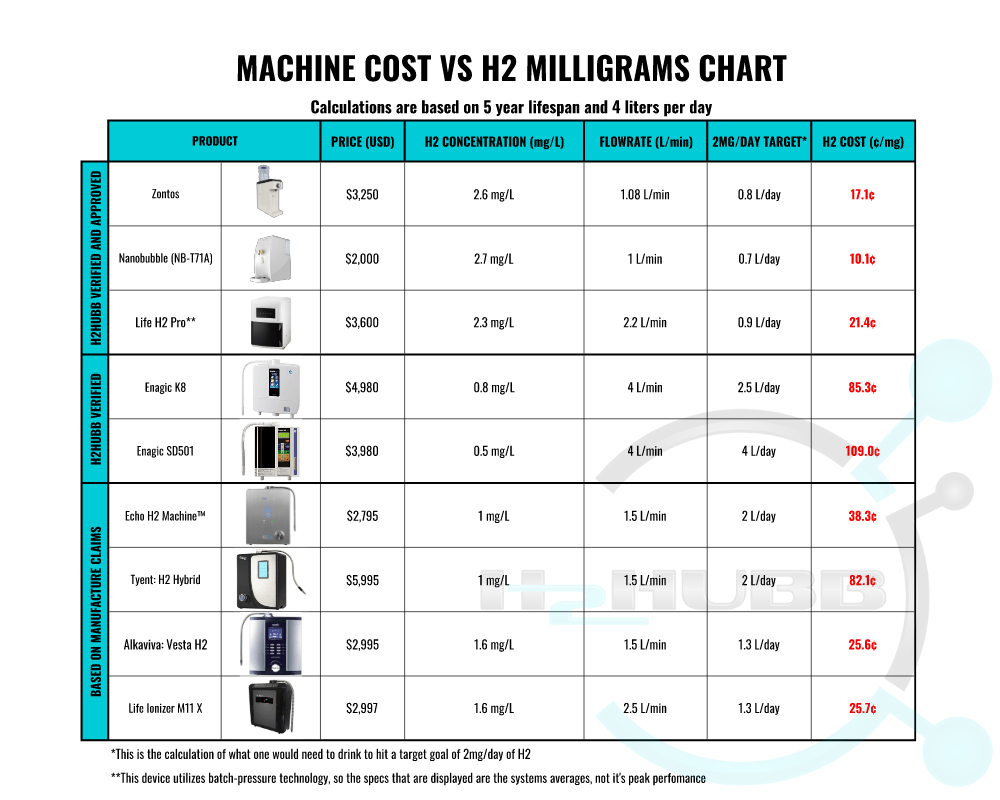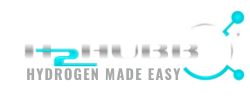Over the years, several water-ionizer companies, some of which are now hydrogen water companies, have created “customer charts” to display their hydrogen water generators or alkaline water ionizers as better than others on the market. These charts display certain metrics or values that would be important to the customer and the company that created them. The charts feature metrics such as cost, pH range, negative ORP value, power supply type, power efficiency (watts), warranty, etc. In recent years, some of these charts have displayed H2 concentration as well. Nevertheless, most of these charts fail to correlate the cost of the hydrogen water generator or alkaline water ionizer with the true “therapeutic value” of the system: Cost of the milligrams of H2 provided by the device.
I have discussed many times the suggested therapeutic dose of molecular hydrogen for humans based on the research and it’s so important it’s worth mentioning again in this article. Here is an excerpt from my article: “H2HUBB Rebuttal | Time Article: Is Hydrogen Water Actually Good For You?”, where I touch on the suggested therapeutic dosage for humans based on the research. Please visit that article as well if you’re interested in that read. I think our rebuttal was sufficient and adequately addressed the primary misinterpretation.
“It is true that the administration dose for molecular hydrogen via water is still under investigation. Researchers and experts in the field have yet to come to an official consensus (release an official statement) about a specified dosage level (milligrams) of molecular hydrogen for each disease model, but there is an agreement that the research is suggesting 1~3 mg/day of H2 is what is seen throughout the literature to produce therapeutic effects in humans, with 0.5 mg/day appearing to be more of a minimum threshold. Furthermore, preclinical and clinical human studies are administering 1~15 mg of H2 per day, and are seeing statistical improvements in various disease models.[24][25][26][27][28][29]”
So, as you see 1~15 mg/day of molecular hydrogen is being used in preclinical and clinical human studies and 1~3 mg/day of H2 via water appears to be therapeutic in human studies. Therefore, if you’re in the market for a hydrogen water generator, the device that can provide the most milligrams of H2 at the lowest cost is the most valuable device in terms of therapeutic potential over time.
Quick note, to calculate the potential ingested milligram amount of H2, you will need to multiply the dissolved hydrogen concentration (in mg/L (ppm)) by the ingested volume (in liters).
Equation: mg/L x L = mg
It’s imperative you know this information, as you will not be able to calculate how much molecular hydrogen you are ingesting apart from it. You can learn more about this at our related science page and can calculate this ingested milligram amount on our calculator page.
Now, after hours of contemplation and time spent talking this concept over with another educated colleague of mine, I believe we have come up with a fairly accurate way of displaying the cost vs therapeutic potential (milligrams of H2) for the most popular hydrogen water generators available to those in the US.
There are a few assumptions that I had to make but I think they are reasonable and close to real-world figures. This is important as this would be the first consumer chart that actually demonstrates which hydrogen water generators have the least cost per mg of H2 provided over time.

To fully understand the “Cost vs H2 Milligrams Chart” there are several variables that must be considered. First, the chart is based on a 5-year span of time. Most of these systems come with a 1~5 year warranty, and in my experience, 3~5 years appears to be the life-span of many devices on the market.
Secondly, the cent/milligram unit (¢/mg) is based on the price of the system, the H2 concentration of the dispensed water (mg/L (ppm)), and how much water is dispensed over the 5-year time-span (Liters). With these metrics, we can calculate the amount of hydrogen gas the unit can provide in cents per milligram.
Thirdly, in terms of how much water is dispensed, every hydrogen water generator on the chart is assumed to dispense 4L (1 gal)/day. This is also a reasonable figure over the course of the 5 year period.
Lastly, the hydrogen water systems that have the lowest H2 cost (¢/mg) (displayed in red), the lowest volume of water (L/day) needed to achieve the 2 mg/day target, and have had their specs verified and approved by H2HUBB, are the top performers. For instance, based on the chat the Nanobubble Hydrogen Water System is the top performer as it excels in all three categories.
Take-Aways
This chart is not meant to tell you every advantage or disadvantage of each system. Furthermore, it doesn’t not factor in the yearly maintenance costs of the system. There are a myriad of values that can contribute to the cost of the systems, even the cost of water and electricity.
The chart is meant to specifically address how much it will cost for each system to provide a milligram of hydrogen gas to you via water over the course of 5 years. The hydrogen water generators that have the lowest “¢/mg” value tend to be the best “bang for your buck” device. You can also see that the hydrogen water systems that have the highest H2 concentration, decent dispensing flow rate (L/min), and lowest price point tend to have the better “¢/mg” over time. Thus they are the more attractive units.
Keep in mind, more than half of these units are not recommended by H2HUBB, as they have not undergone our evaluation and recommendation process. This means that most of these units’ metrics are claims made by the manufacturers or their distributors and have not been independently validated by a third-party testing source. Therefore, the results associated with these units need to be taken with a big grain of salt. That also means the ¢/mg value for these non-tested units are likely best-case scenarios. Until these systems are tested for dissolved hydrogen concentration and flow rate (L/min) by H2HUBB or a company such as H2 Analytics, their actual numbers can be extremely different from our approximate figures. The hydrogen water systems that are stated as “H2HUBB Verified and Approved” or “verified” have been tested by H2HUBB either officially or unofficially to confirm their H2 concentration and dispensing flow rate (L/min). Therefore, these approximate numbers are closer to actual real-world figures and more reliable to use when making an informed decision about purchasing.
Lastly, as I stated above, these are approximate figures based on our calculations-we are not stating that these are exact figures but they are close with the “H2HUBB Verified and Approved” or “verified” products. The chart is meant to give you an idea of the cost associated with the therapeutic agent in this water, molecular hydrogen, and how much the research suggests you should have.
Contact us if you have any questions.
